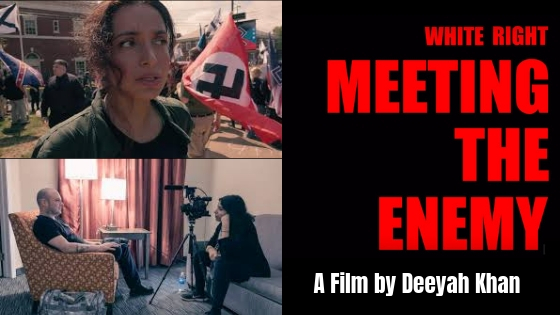This week I have felt some discouragement around the internecine fighting over Ilhan Omar’s critiques of Israel.[1]
The worst I feel I could say about some of congresswoman’s Omar’s past comments is that maybe they came off as glib and uninformed, e.g. “It’s all about the Benjamins.” Thing is, I don’t know if she wasn’t speaking some truth, if perhaps inelegantly. I don’t think measured critique of our allies, even Israel, whose leadership is not exactly beyond reproach these days,[2] should be out of bounds. Reasonable examination certainly should not be conflated with hate speech.
Full disclosure, I personally find congresswoman Ilhan Omar’s election to congress as the BEST of what the US can be. Her journey from Somali refugee camp to the halls of Congress is nothing short of inspiring. By contrast, some of the racist reactions to her election, such as the poster in the West Virginia legislature linking her to the 9/11 attacks, represents the WORST of our country.[3] Rep. Ilhan Omar has made some missteps in her choice of language—I should note white people do this all the time and expect grace from those they offend. Some criticism of her is warranted. But trying to link her to 9/11 is just outside the circle of acceptable discourse.
It is the weird time we live in today that these two manifestations of our country’s conflicted legacy, the story of a Somali refugee elected to congress and the hateful response in the West Virginia legislature, are juxtaposed with such prominence. These contradictions have always been present in our country’s character, as any person of color. Perhaps it is valuable they are revealed so starkly now. It can give us opportunity to address our failures and faults. But the opportunity to repair and redress makes that poster linking Ilhan Omar to 9/11 and the intent behind it no less vile.
Stepping back from that undeniably racist act, this current fracas over whether representative Ilhan Omar’s remarks amount to anti-Semitism or that any criticism of her is tantamount to sexism, racism, islamophobia, makes me wonder: “How do those of us engaged in reconciliation dialogue provide reflection, feedback, critique to one another without being accused of defensiveness—or worse: ‘anti-Semitism; racism; sexism; homophobia; Islamophobia?” As un-politic as it is for me to point out, our inclusion in a marginalized group should not inoculate us from criticism. Furthermore, criticism in itself, does not always equal a more pernicious “ism.”
Inserting my own commentary on this is especially troublesome, as I am a person who sits squarely in the category of “benefiting from white, educated, hetero, male, WASP privilege.” I’m not sure I should be suggesting anything as much as I should simply be listening to others right now. If I write nothing else on this topic, it should probably be that.
But if you want to keep reading, I’ll volunteer the following.
On the Israel and Palestinian conflict, Steven Spielberg reflected, after filming Schindler's List, that the tragedy of oppressed communities taking aim at one another was acutely painful since, “They see the face of their oppressors in each other,” thus they are blind to the true identity and the suffering of one another. This blindness robs them of an opportunity for solidarity.
All I know is that self-reflection, humility, and tolerance must be part of our posture in reconciliation work. And this is hard! I can’t speak with much credibility as to how members of other more marginalized communities should act in all this. They have endured centuries of pain that I will never truly understand. But I am moved to reflect upon my own demographic: educated white males.
Exhibit A: this article in the Atlantic that examines the level of partisanship, tolerance (or lack thereof) in the US. The studies cited in the article found that educated urban whites are the least politically tolerant people in America. We seem to be in a rush to “virtue” signal our own outrage at various “isms.” As the article states:
“In general, the most politically intolerant Americans, according to the analysis, tend to be whiter, more highly educated, older, more urban, and more partisan themselves. . . White, highly educated people . . .don’t routinely talk with people who disagree with them; this isolation makes it easier for them to caricature their ideological opponents. In fact, people who went to graduate school have the least amount of political disagreement in their lives. . . they [are] quicker to assume the worst about their political counterparts.”[4]
Oh sh**. They are talking about me.
Intolerant of political opponents that I see as racist, homophobic, Anti-Semitic, Islamophobic, and close-minded? Yep. Caricaturing them? I am guilty of that, too. Advocating violence towards them? Well, I’ve definitely re-posted gifs of Neo-Nazis getting punched in the face.
And I still don’t regret it.
But that leaves me wondering if my glee in posting a video of Richard Spenser getting decked is just a more extreme point on a continuum of intolerance. It’s me virtue-signaling my “woke-ness” from a pedestal of self-righteousness. I think a lot of white folks find ourselves on this pedestal sometimes. But let’s be frank: should I really be staking a claim to Mt. Pious, when I should probably be decrying violence in any context? Tolerance and non-violent opposition are the way to go. Right?
Well, maybe not? There are thinkers like Sam Harris (whom I respect deeply) who say we CAN’T allow ourselves to tolerate hate, ever, even if hate tries to defend itself under the guise of freedom of religion or freedom of speech. Tolerance in that case is simply a trap. So punch away.
<Groan> It’s enough to make my head spin.
My own back-and-forth brings to mind what a therapist friend recently pointed out to me: there is a difference between “hurt” and “harm.” In that, there are times we must say things to others, whom we love, that may hurt them, such as frank feedback and honest criticism. For example: “Honorable Rep. Ilhan Omar, you might not realize this but linking Jews to ‘Benjamins’ is a dog-whistle used by Neo-Nazis. Maybe don’t use it when presenting valid questions regarding the influence of the Israeli lobby.”
Feedback such as this might sting our egos or even hurt our hearts a bit, but it’s different from words and actions meant to harm—words that are said in malice with intent to dehumanize, control, or cause pain and suffering.
As traditional allies in congress find themselves divided and lining up against one another and lobbing accusations of slander and racism—I am reminded of Spielberg’s observations on oppressed communities turning one each other mentioned above.
All I can’t think of is the imperative to “talk less and listen more.”
Maybe congresswoman Ilham Omar’s comments might have hurt, but were they really meant to harm? Was there some truth in her comments that shed light on the pernicious role of money in politics, the power of political lobbies, and the suffering of the Palestinian people? Did representative Ilham Omar’s comments really qualify as hate speech? Does counter-criticism of her amount to sexist, Islamophobic, racism?
I’d like to think that I can acknowledge the inhumane living conditions in Gaza while not being called anti-Semitic. Can I describe Ilham Omar’s “Benjamins” comment as glib and reckless, without being labeled racist?
I’d like to think, as a society, we can hold space for the current humanitarian tragedy in Gaza and the horrors of the Holocaust, without denying the suffering and evil inherent in either.
Can’t we?
I’ll repeat, I’m in a problematic position here. I’m a person a privilege and I’m not a member of any of the groups claiming offense in the most recent skirmish. But this is a troubling position a lot of white, well-intentioned people of privilege find ourselves in. When in doubt, likely we should err on the side of listening. (But here I go ignoring my own advice):
I do wonder if this is a time for a bit of personal resilience. A time to take a deep breath before reacting. A time to pause and reflect before responding. Otherwise it’s as if we’re just feeding the beast, the cycle of recrimination, reproach, and moral sanctimony.
Then again, that is all too easy for me to say, right, as a WASP-y privileged bystander. Noted. But I think it’s even good advice white people need to heed when listening to the stories of people of color. Even if bearing witness to poc’s pain “hurts” us with our own pangs of guilt, it doesn’t harm us in the long run. Quite the opposite, that hurt can bring healing. I believe that white people claiming “white discrimination” are actually conflating hurt and harm. Sure, the feedback about white privilege might sting, but it is NOT on par with the discrimination people of color have endured for centuries. So take a deep breath and sit down. Good medicine doesn’t always taste good, but it can cure what ails you.
More broadly, if all these divisions are not a sign to continue to engage, to listen, to learn, to reflect, to check our own sanctimony and not to isolate ourselves into ideological tribes, I’m not sure what is. More than ever I appreciate the words of Governor Jerry Brown when he reminded us of the value of the American civic identity, one that embraces: tolerance, diversity, freedom of speech, of the press, of faith, equal access to opportunity and protections of the law. We haven’t always lived up to these ideals, but we can keep working towards them. As the studies in the Atlantic article show, some US communities are doing this better than others. It’s worth a full read.
I hope I still don’t sound like a Polly-Anna when I wish that we can still be: Out of Many, One.
___________________________________________________
[1] https://www.washingtonpost.com/politics/house-democrats-erupt-in-protests-over-indirect-sanction-of-rep-omar-for-alleged-anti-semitism/2019/03/06/c06bcd18-4022-11e9-85ad-779ef05fd9d8_story.html?utm_term=.cb0e9ec78ec4
[2] https://www.lawfareblog.com/israels-attorney-general-moves-forward-netanyahus-indictment-what-happens-next
[3] https://www.npr.org/2019/03/02/699699805/sign-linking-muslim-congresswoman-ilhan-omar-to-9-11-sparks-outrage-in-west-virg
[4] https://www.theatlantic.com/politics/archive/2019/03/us-counties-vary-their-degree-partisan-prejudice/583072/












